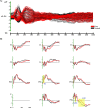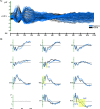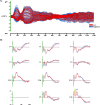How context influences the interpretation of facial expressions: a source localization high-density EEG study on the "Kuleshov effect"
- PMID: 30765713
- PMCID: PMC6376122
- DOI: 10.1038/s41598-018-37786-y
How context influences the interpretation of facial expressions: a source localization high-density EEG study on the "Kuleshov effect"
Abstract
Few studies have explored the specificities of contextual modulations of the processing of facial expressions at a neuronal level. This study fills this gap by employing an original paradigm, based on a version of the filmic "Kuleshov effect". High-density EEG was recorded while participants watched film sequences consisting of three shots: the close-up of a target person's neutral face (Face_1), the scene that the target person was looking at (happy, fearful, or neutral), and another close-up of the same target person's neutral face (Face_2). The participants' task was to rate both valence and arousal, and subsequently to categorize the target person's emotional state. The results indicate that despite a significant behavioural 'context' effect, the electrophysiological indexes still indicate that the face is evaluated as neutral. Specifically, Face_2 elicited a high amplitude N170 when preceded by neutral contexts, and a high amplitude Late Positive Potential (LPP) when preceded by emotional contexts, thus showing sensitivity to the evaluative congruence (N170) and incongruence (LPP) between context and Face_2. The LPP activity was mainly underpinned by brain regions involved in facial expressions and emotion recognition processing. Our results shed new light on temporal and neural correlates of context-sensitivity in the interpretation of facial expressions.
Conflict of interest statement
The authors declare no competing interests.
Figures








References
-
- Russell, J. A. Reading emotions from and into faces: resurrecting a dimensional contextual perspective in The psychology of facial expressions. (eds Russell, J. A. & Fernandez-Dols, J. M.) 295–320 New York (Cambridge University Press, 1997).

